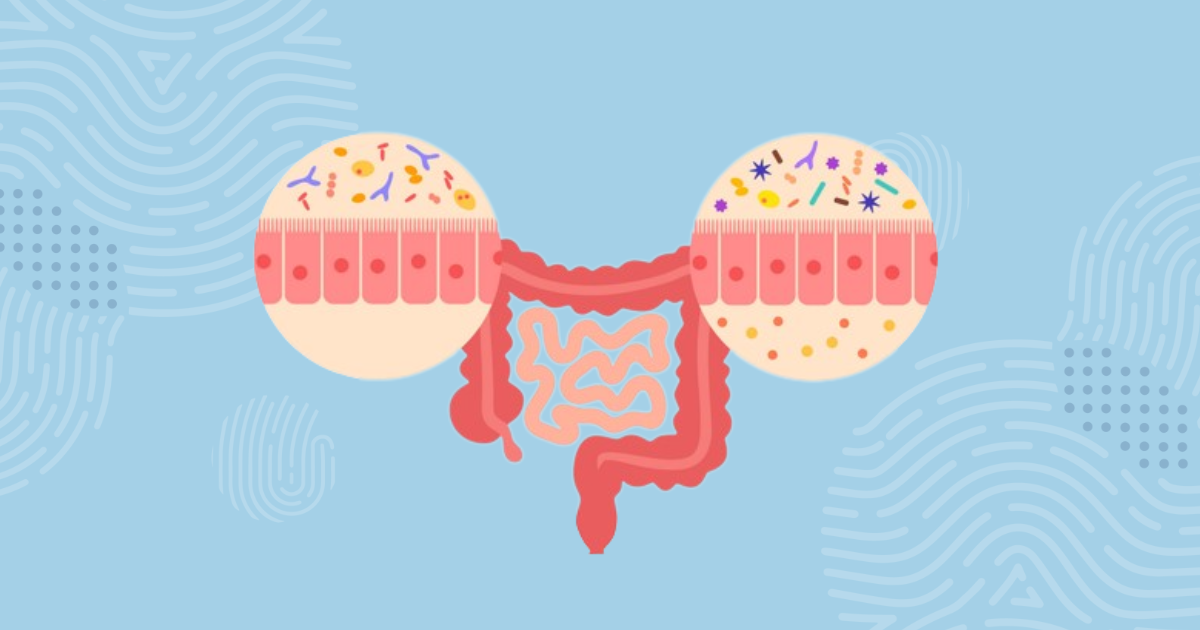What Is Gut Microbiota and Why Is It Important?

Gut microbiota refers to everything that lives in the gut, which is not of our own body. Here we find fungi, bacteria, archaea, and viruses. We call it the gut microbiota. Your body has its unique cell material, not accepting any other tissue as its own. The immune system would not allow it. Inside your body, your microbiota is of a completely different cell material. Yet, our body accepts this, as they live on the skin surface.
Well, how come the gut is part of the body’s skin surface? Is the gut not residing within our body? Yes, of course. Like all animals in the multicellular kingdom, the digestive tube has a mouth and anus. The early stages of embryo development form the digestive tube. Here, it develops as part of the skin. The skin folds inwards to form the digestive tube. This way it protects the body from what is not part of the body's own cell material.
Colonize and produce biofilm
The microbiota lives as a biofilm that covers the body's surfaces. We have plenty of surface areas for biofilm to exist. For example teeth, ears, skin, vagina, lungs, and gut. What this biofilm microbiota contains, varies from person to person. It is individual. It depends on how we were born. Cesarean section or natural? At home or in the hospital? The type of microbiota our mother and father carry. It also depends on the in- and outdoor air and bedding microbiota. Do we live with dogs, cats, or other animals? Are we living in the city or rural areas? Are we part of indigenous people or city dwellers? It depends on where on this planet we live, the water we bathe in, the clothes we change into, and finally what we eat.
Our meals and their source are most likely the greatest force for the microbiota to colonize our gut. Food is a transport medium, and just like for us, an energy source for microbiota. The environment where the food is grown and produced is the source. Microbiota passing through the digestive system will most likely colonize our gut. Some may work as possible probiotics and even biotherapeutics. And some bacteria live in the gut thanks to other bacteria in the gut. They are dependent on neighboring bacteria in the biofilm.
During my Master’s I dived into ecological and physiological microbiology. I learned that as much as over 99% of the billions of bacteria that live in a teaspoon of the earth are harmless to humans. Children play with earth, sand, dust, and water - the environment that surrounds them. This is an immense support to their microbiota and immune system.
Survive and thrive
Which prokaryotes end up in the biofilm on our bodies depends on many factors. First of all, these bacteria must fulfill some criteria if they are to survive in the gut. For example, they must be able to tolerate and proliferate in a lack of oxygen.
As a student, I had the opportunity to experiment with live cultures of Pseudomonas aeruginosa. These bacteria carry genes for exploiting several electron acceptors, oxygen as well as nitrogen oxides (NOx-). To deliver an environment with nitrogen oxides (NOx–) as electron acceptors, I first had to create an environment that contained no traces of oxygen. Finetuned instruments and pressure handling helped me in doing this. If not, the Pseudomonas would not thrive on nitrogen oxides (NOx–). Like all bacteria, the P.aeruginosa was turning on and off genes depending on environmental signals.
The Pseudomonas group lives and thrives in soil, water, and gut. Both are places where oxygen is either not available, or available to a varying degree. Most bacteria in the gut do not tolerate any traces of oxygen, and therefore they thrive in the gut environment.
Bacteria are experts in utilizing their genomes and survive environmental changes. That is if they retain genes for several types of environments. If allowed, some grow fast compared to others. The fast-growing ones are opportunists and not necessarily harmful to humans. Opportunists live excellently in the gut, skin, vagina, mouth, or lungs. But, they are not always the perfect bacteria to inhabit our bodies. An opportunist may also carry genes for toxin production or antibiotic resistance. A pathogen that causes an infection, if situations allow it, and carries resistance is a perfect opportunist.
Healthy and dysbiotic microbiota - what do we know?
Food and the environment are strong forces that affect our wellbeing. They can do it both in a good and bad way. They provide microbes to our interior skin surface - or the gut. Sometimes they carry pathogens that may colonize our interior. Pathogens are harmful because they are able to compete with our own cell material and infect the epithelial layer (skin surface). In addition, they may harbor resistant functions against antibiotics and disinfectants. This resistance is unfortunate, but a more and more common function of our gut microbiota.
Helicobacter pylori and Clostridium difficile are examples of known human pathogens of the gastrointestinal tract. Both cause severe infections of the gut epithelial layer. Both require targeted treatment, which mostly relies on antibiotics.
When exposing gut microbiota to antibiotics, this resistance will be selected, meaning that some bacteria will survive the antibiotic. Resistant bacteria will survive the antibiotic treatment and continue to proliferate. While, if you are really unlucky, the healthy bacteria might die with the treatment. That will cause a clear shift in the normal gut microbiota. Dysbiosis is any such change from a balanced, healthy gut microbiota towards an imbalanced and unhealthy one.
Loss of bacteria might lead to loss of diversity - leading to a shift from healthy to dysbiotic microbiota. These respective, and already mentioned environmental factors, lead to low gut microbiome diversity, including Cesarean section, infant formula, antibiotics, sanitation, a diet low in fibers, and high in saturated fat, artificial sweeteners, and emulsifiers.

Why is gut microbiota important?
There tends to be a clear difference between the two umbrellas of gut microbiota: normobiosis and dysbiotic. Normobiosis is every healthy microbiome known. Thus, researchers may incorporate a healthy reference when studying gut imbalance and illnesses. They use this to validate if an individual’s microbiota is dysbiotic.
Often, a dysbiotic gut microbiota comes together with many other illnesses and bad symptoms: diarrhea, digestive problems, food intolerance, gas, and bloating, acne, skin rashes, and psoriasis, among others on a longer list. In research, the gut microbiota links headfast to health and disease.
To restore health, if disease occurs, it is very helpful to know your individual microbiota. An absolutely helpful tool is to compare your gut status to a scientifically based healthy reference population. Your own gut microbiota state might become crucial in the future effort to remedy your illnesses.
Unique gut microbiota
Individual gut microbiota – what is that? Gut microbiomes could be sorted into taxonomic examples of bacteria and their function. Taxonomy is the system we use to classify and sort any living organism in the field of biology. Basically it is our way of naming organisms and knowing who their relatives are. And this is very common to do. However, listing all the taxonomic names within microbiology has its problems and issues. Each individual taxon is not giving very much information on its own. We need to know their relevance. What do they do? How do they interact in the gut environment?
From a fecal sample, it is possible to map the number of bacterial groups living in the gut. Furthermore, we can look deeper and find bacterial species. Thus, we also will find their function. That is if basic science - research aimed at understanding fundamental problems - already understands how these particular species work. By mapping function, we see whether the bacteria are good or bad.
In gut microbiota, we find all sorts of bacterial names. A normal human gut microbiome contains about 250 different bacteria, while in number of cells they exist in trillions combined. We carry personal amounts of each of these bacteria, mostly dependent on the type of food and environment we are exposed to. Thus an individual's gut microbiome is unique. Even so, a gut microbiome conserves its functions. This means that many different bacteria do more or less the same function in our gut. In other words, gut microbiota traits are often redundant. This makes many of the essential mechanisms equal among healthy individuals.
Looking from this perspective, our gut microbiota seems less unique. The question that arises, is this point of view closer to reality when looking into the health of our gut, making the word uniqueness superfluous?
There are several mentioned bacteria that can do more or less the same in the gut. A healthy gut microbiota consists mainly of large groups of bacteria called Bacteroidetes, Firmicutes, and Actinobacteria. They work in similar ways. True – they tolerate the lack of oxygen, and many do not tolerate oxygen at all. Most importantly, they ferment all the small particles of food that escape our body’s own enzymatic processes. Bacteria that ferment fits under the normobiotic umbrella. The end-product is mainly gasses and short-chain fatty acids (SCFAs).

Thanks to other bacteria
Thanks to other bacteria in the gut, the diverse normobiosis of our gut is maintained. Some bacteria live in the gut thanks to other bacteria in the gut. They are dependent on neighboring bacteria in the biofilm. As mentioned, many bacteria produce SCFAs. They do this from food rich in fiber, such as all sorts of vegetables. And many other bacteria survive and thrive on consuming SCFA molecules. Without them, they might get extinct in our gut biofilm. In such cases, we are dangerously close to experiencing dysbiosis.
SCFAs
SCFAs, the final molecules from healthy microbiota, have been found to carry many health benefits to our bodies. Examples of SCFAs are acetate, propionate, and butyrate. Often, they act against illnesses involved with inflammation, or they reduce the cholesterol levels in our blood. These SCAFs, acetate, propionate, and butyrate, are produced in a ratio of 10:2:1, respectively.
However, this depends on what we include in our meals. Butyrate-producing bacteria are therefore very important species to look out for. For example, two genera called Faecalibacterium and Bifidobacterium rely on each other for survival and thriving. The genus Faecalibacterium consumes acetate produced from Bifidobacterium. In return, Faeaclibacterium produces butyrate. The latter thrives in our guts thanks to what we eat, but most importantly Faecalibacterium (often a marker of good health) blooms in the presence of acetate-producers, like Bifidobacterium.
Propionate
Another well-known, common, and abundant bacteria in healthy microbiota is Akkermansia municiphila. Research has shown that a wide range of health disorders are strongly associated with the low relative abundance of this species, A. municiphila. The presence of this species adds some very beneficial health functions. A. muciniphila primarily feeds on mucin, a glycoprotein coating our intestinal barrier and produced by our body.
When we experience fasting, this bacterium increases in abundance because it feeds on mucin. While doing so, it produces propionate, a short chain fatty-acid involved in maintaining the barrier integrity. In addition to all SCAFs, propionate has a great anti-inflammatory property in the human intestine. Also, it has been shown that A.municiphila works synergistically together with the Folfox-treatment when preventing colon cancer in mice.
Profile of the gut microbiome
As already mentioned, gut microbiota is not the same as our personal cell material. Thus, it is possible to separate from our bodies. We can extract and analyze its content. The gut waste material, feces, contains examples of our unique individual gut microbiota. We call it the microbiome - a collection of all the microbial genes or genomes of the microbiota.
One way of profiling your gut microbiome is using the GA-map® Dysbiosis test. This is a reliable, informative, and research-based test to better know your gut microbiome profile and if it is healthy or dysbiotic. Today, it is the only one in the world that compares your gut state against a well-defined and large, healthy gut microbiome reference. As this healthy reference is scientifically based, this is the most confident way to define your gut's dysbiosis or normobiosis.
Research worldwide is already using the test to dig deeper into gut health and disease links. The strength of this test is its comparison to a scientifically based healthy gut microbiome. The samples that built the reference are sourced from all over Europe. Ongoing sampling proves that the GA-map® Dysbiosis test also maps healthy microbiota worldwide. This makes dysbiotic inferences from the GA-map® Dysbiosis test relevant all over the world.
